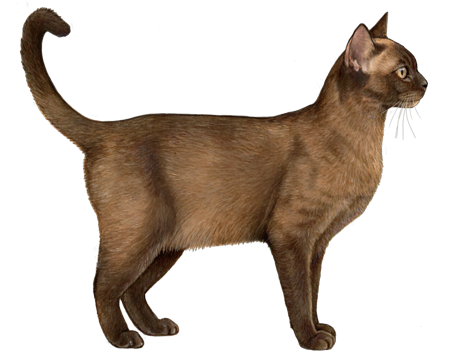
Singapura
Though small, Singapuras are bursting with energy. They thrive on interactions with their humans and make affectionate family pets. This extroverted breed likes to be involved in all the household happenings.
Interested in discovering if your cat is a Singapura?
Check out Wisdom Panel's DNA test.
Singapura Traits
General Appearance
The Singapura is the smallest registered cat breed, with males maxing out around eight pounds. These kitties have compact, muscular bodies and long, medium-boned legs.
Coat and Coloring
The Singapura's coat is very short and close-lying, with a fine, silky texture. And it comes in just one color: sepia agouti. (That translates to dark brown ticking on a warm ivory ground color.) Each hair has at least two bands of dark ticking, which are separated by light bands. These cats also have a tabby "M" on their forehead and a dark tail tip.
Distinctive Physical Traits
Distinguishing features of the Singapura include a rounded head, blunt nose, and large, slightly pointed ears. Their eyes are large and almond-shaped and come in hazel, green, or yellow.
Singapura Temperament
Singapuras are extremely curious, outgoing cats that like to help their people out around the house—whether they need it or not. Cooking, reading, folding laundry, and watching TV are all activities one can expect to do with a Singapura by their side.
To get a better view of the world around them, these cats like to be up off the ground. Cat trees and kitchen cabinets will work for this purpose, as will the shoulders of the nearest human.
Singapuras are gentle cats that get along well with other pets and kids. And don't let their small size fool you. These cats are little firecrackers. They keep busy and are always eager to play—especially if it means spending more time with their beloved family members.
Singapura History
Singapura is the Malaysian word for "Singapore," which is this breed's place of origin. On the island, cats resembling the Singapura—with their dark brown ticked coats—have been around since 1965. In fact, experts believe the ticked pattern originated in Southeast Asia.
In 1971 Hal Meadow, an American geophysicist working overseas, sent several ticked cats from Singapore to Tommy Meadow in the United States. Tommy bred the cats, and the Meadows used the offspring to develop a Singapura breeding program in the U.S.
Solid brown cats sometimes appeared in litters, and by the mid-1980s, breeders realized that Singapuras carried a recessive gene for solid color. Through a process of test-mating, breeders removed cats with the recessive gene from the breeding pool to preserve the Singapura's trademark ticked coat.
The CFA granted the Singapura Championship status in 1988. Today, it remains a relatively rare breed with a very devoted following.
Singapura Care
Nutrition
Singapuras require a high-quality diet formulated for their life stage (e.g., kitten, adult, senior). Many Singapuras do well on diets high in fat and protein.
All cats are at risk of obesity if they eat too much. One easy way to avoid overfeeding is to use a standard measuring cup to portion out their food. And don't forget to account for treats or snacks—especially if giving human food. Just one ounce of cheese can account for half the daily calories of small cats like the Singapura.
Lastly, all cats need access to fresh, clean water around the clock.
Grooming
The Singapura's short coat is easy to maintain. Weekly brushing is enough to keep it free of loose fur—though many Singapuras appreciate more frequent grooming sessions.
Most cats' nails require monthly trimming to prevent them from getting too long. Long nails are more likely to snag on something and become torn or damaged. They can even grow into your cat's paw pads, leading to pain or infection. In addition to clipping, providing a scratching post will allow your cat to do some nail maintenance themselves (thanks to their instinct to scratch).
No grooming routine is complete without a little dental hygiene. To support your Singapura's overall health, brush their teeth daily and schedule visits with your veterinarian for professional dental cleanings and exams.
Health
Singapuras may be more prone to developing Hypertrophic Cardiomyopathy—which decreases the heart's efficiency and can lead to other issues. Your veterinarian is the best resource for discussing this condition and other health concerns about your cat.
Singapura Genetic Health Conditions
-
Progressive Retinal Atrophy (Discovered in the Abyssinian)
Progressive Retinal Atrophy (Discovered in the Abyssinian) is a disorder that causes degeneration of the light sensing retina at the back of the eye, resulting in vision loss.
-
Pyruvate Kinase Deficiency
Pyruvate Kinase (PK) Deficiency is a disorder that causes anemia due to the breakdown of red blood cells.
With more than 45 health tests, Wisdom Panel™ Complete for Cats screens for these and other important genetic conditions—allowing you to better plan for your cat's lifelong care.
Breed Group
Asian
The Asian Group is comprised mainly of genetically similar breeds which vary widely in traits and personalities. These breeds are distinct from those of the Siamese and Oriental Group.
Resources
https://cfa.org/singapura/singapura-article-2006/
https://tica.org/breeds/browse-all-breeds?view=article&id=879:singapura-breed&catid=79
https://cfa.org/wp-content/uploads/2019/06/singapura-standard.pdf
https://tica.org/breeds/browse-all-breeds?view=article&id=1874
Reviewed February 23, 2021 by Annette Louviere, DVM













